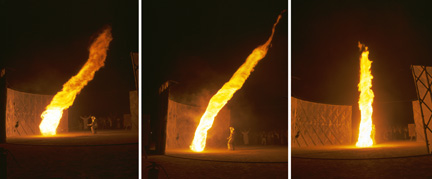| ORDER/SUBSCRIBE SPONSORS CONTACT WHAT'S NEW INDEX/SEARCH HOME | |||||
The Leonardo GalleryFire Vortexby Nate Smith
The making of fire art often relies on the ability to transcend instinctual fear. So profound is our relationship to fire, that the mere presence of flame is usually enough to incite a deep anthropological reaction that draws the viewer unwittingly to both fear and fascination. The art of working with fire is the ability to transport the viewer to something beyond basic instinctual recognitions and toward a deep awareness of the immense beauty which fire naturally possesses. One way I've found of providing an access to this beauty is by helping people experience the fluid nature of fire. People perceive beauty in fluid motion much like they perceive beauty. Symmetry in form and motion, light and color all play a part in people's perceptions of beauty in fire. Much of my work has centered on manipulating the flow of fire into different forms and shapes, creating temporary sculptures made entirely of flame. By using techniques like manipulating the moment when fuel and oxygen react or controlling the flow and location of gas jets and pressurized openings, I've been able to obtain different vortex shapes that I've fondly dubbed Lion Tails, Dragon Tails, Carrot Fire, Jet Cones and Corkscrews. I create some of the shapes with machines I've made and some by hand, but all the shapes I've created help capture the elusive beauty of fire flowing from one form to another. It's something we're rarely privileged to witness elsewhere, especially from a place of wonder instead of fear. The other side of fear is fascination. We all have a basic instinctual fear of fire. When we give up that fear, we then have access to its beauty. I've done a lot of work at Burning Man (the fire vortexes appeared in 2002, 2003 and 2004) because it's a perfect place for large scale fire art. What I create are Fire Vortexes: tornados of flame - spinning columns of rising fire that reach up to sixty feet in height. To produce a fire vortex, I begin by manipulating air into a vortex shape by directing it with powerful fans or rotating vanes. When a vortex is established, I introduce propane into the base using a device which I've humorously described as my 'magic fire wand', designed specifically for this purpose. The opening through which the gas flows from the fire wand is one of the most important parts of the system. The shape of the opening and the speed of the gas flowing out make a tremendous difference in the final shape of the fire. A control allowing delicate adjustment of the speed of the fuel is located on the handle of the wand. This is where a good deal of the subtlety of flame shaping happens. If the gas comes out too fast or in the wrong place, it can obliterate the vortex form instead of shaping it. However, if the gas is artfully adjusted, it can create gorgeous undulating fire sculptures of great beauty. Once the fuel has been fed into the vortex using the fire wand, it's ignited by a pilot flame and instantly drawn upward into a fiery manifestation of fluid dynamics at work. When people see good fire art, what happens most of the time is that they smile. When they smile it kicks in another built in human response. It makes me smile to make you smile. It's as simple as that. Nate Smith. E-mail: nate at fire-arts dot com | |||||
|
Updated 21 February 2007.
|
|||||









